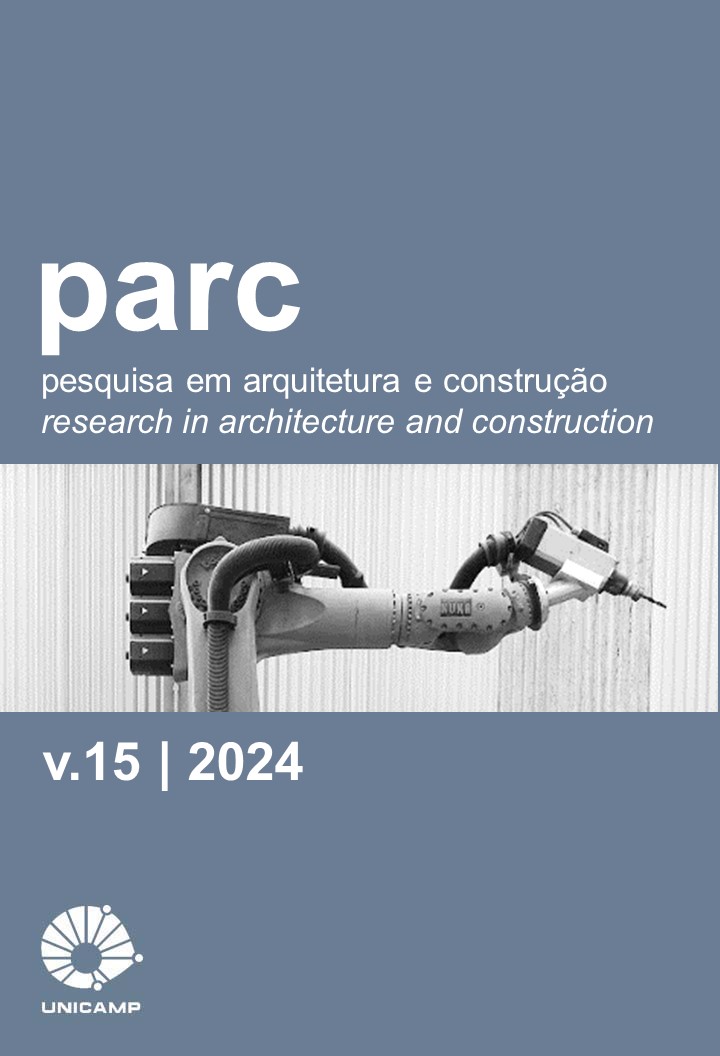Abstract
Adequate daylighting in work environments is essential for users’ health and well-being. Fenestration configuration is one of the factors that impact visual comfort the most, and over time, windows have grown in the area until the “curtain glass facades” became omnipresent. This work investigated the effect of daylight in office spaces in building models located in Vitória, ES, with different configurations concerning the building stories, window characteristics, and the Window-to-Wall Ratio (WWR). The methodology uses dynamic simulations over one year through the DIVA-for-Rhino software and analyzes the light transmission (LT) variation and influence of external shading elements when present. The results show that the brise-soleils greatly influence visual comfort, increasing uniformity of the incoming light and reducing the occurrence of excessive illuminances and intolerable glare. However, their use must be well planned, as they can reduce illuminance if attached to low WWR facades and low light transmission index glazing. The surrounding obstruction impacts the stories closest to the ground. In conclusion, no ideal model addresses the best daylighting performance in relation to all the metrics studied, leaving it to the designer to define the most adequate configurations for the situation at hand.
References
ABNT - ASSOCIAÇÃO BRASILEIRA DE NORMAS TÉCNICAS. NBR ISSO/CIE 8995-1. Iluminação de ambientes de trabalho – Parte 1: interior. Rio de Janeiro: ABNT, 2013.
ANDRADE, C. A história do ambiente de trabalho em edifícios de escritórios: um século de transformações. São Carlos: C4, 2007.
BAKER, M.; FANCHIOTTI, A.; STEEMERTS, K. Daylight Design of buildings. London: James & James ltd., 2002.
BARDHAN, R. e DEBNATH, R. Towards daylight inclusive bye-law: Daylight as an energy saving route for affordable housing in India. Energy for Sustainable Development, n. 34, p. 1–9, 2016.
BERARDI, U.; ANARAKI, H. K. Analysis of the Impacts of Light Shelves on the Useful Daylight Illuminance in Office Buildings. Toronto. Energy Procedia, v. 78, p.1793-1798, nov. 2015.
BOUBEKRI, M.; CHEUNG, I. N; REID, K. J.; WANG, C.; ZEE, P. C. Impact of Windows and Daylight Exposure on Overall Health and Sleep Quality of Office Workers. Journal of ckinical Sleep Medicine, v. 10, n. 6, p. 603–611, 2014.
BOYCE, P. R. Human Factors in Lighting. 3.ed. New York: Taylor & Francis Group, 2014.
CORBELLA, O. D. E; CASTANHEIRA, R. G. Sobre a necessidade de proteção da radiação solar incidente nas fachadas Sul, para edifícios situados entre as latitudes 10° e 35°. In: VI Encontro Nacional E III Encontro Latino-Americano Sobre Conforto No Ambiente Construído. 2001, São Paulo. Anais [...]. São Pedro: SP, 2001.
FASSINA, S. P. Qualificação dos dispositivos de fachada quanto à disponibilidade de luz natural: o caso do Instituto Federal do Espírito Santo campus Colatina. Tese (Dissertação de metrado em Arquitetura e Urbanismo), Faculdade de Arquitetura e Urbanismo, Universidade de Vila Velha. Vila-Velha, Espírito Santo, 2017.
INPE - INSTITUTO NACIONAL DE PESQUISAS ESPACIAIS. Centro de Previsão de Tempo e Estudos Climáticos. 2019. Disponível em: http://bancodedados.cptec.inpe.br/ . Acesso em: 22 de agosto de 2019.
JAKUBIEC, J. A.; REINHART, C. F. The ‘adaptive zone’ – A concept for assessing discomfort glare throughout daylit spaces. Lighting Research and Technology, n.44, p.149- 170, 2012.
LARANJA, A.C.; FERREIRA, N. S.; ALVAREZ, C. E de. Análise da influência da variação das superfícies refletoras na disponibilidade de iluminação natural no ambiente interno e na extensão de sua profundidade. Labor & Engenho, v.10, n.1, p. 31-45, 2016.
LI, D.H.W.; TSANG, E. K.W. An analysis of daylighting performance for office buildings in Hong Kong. Building and Environment, v. 43, n. 9, p. 1446–1458, 2008.
MAIOLI, R. N.; BARROS, M. C. S. L. S. B.; BARROS, J. D. P. de; MOÇA, I. F. F.; CONINCK, I. M.; PAGEL, E. C. A transformação da fachada na tipologia construtiva de edifícios comerciais verticais em Vitória - ES e sua relação com o conforto ambiental. In: Marcia Regina Werner Schneider Abdala. Complementaridade: Arquitetura, Engenharia e Construção. 1ed.Ponta Grossa (PR): Atena Editora, 2018.
MAIOLI, R. N.; TAUFNER, M. D.; ALVAREZ, C. E. de. A Influência das prateleiras de luz no aproveitamento da luz natural sob obstrução externa. Revista de Arquitectura, n.16, p. 105–113,2014.
MAPELLI, Y. R.; LARANJA, A. C.; ALVAREZ, C. E. de. Avaliação de desempenho entre as tipologias de aberturas zenital e lateral no quesito iluminação natural de ambientes internos. Cadernos Proarq, n.31, p. 83–99, 2018.
NABIL, A. e MARDALJAVIC, J. Useful daylight illuminances: a replacement for daylight factors. Energy and Buldings, London: Elsevier, v. 38, p. 905-913, 2006.
PEREIRA, D. C. L. Iluminação Natural em Edifícios de Escritório: metodologia para a avaliação do desempenho luminoso. 2017. Tese (Doutorado em Engenharia Civil), Faculdade de Arquitetura e Urbanismo, Universidade de São Paulo. São Paulo, São Paulo, 2017.
PMV - PREFEITURA DE VITÓRIA. Lei nº9.271/2018 de 22 de maio de 2018. Aprova o Plano Diretor Urbano do Município de Vitoria e dá outras providências. Diário Oficial do Municipio de Vitória. 2018. Disponível em: http://sistemas.vitoria.es.gov.br/webleis/Arquivos/2018/L9271.PDF . Acesso em: 15 de março de 2019.
REINHART, C. F. et al. Tutorial on the Use of Daysim Simulations for Sustainable Design. Institute for research in Construction National Research Council Canada: Canadá, 2002.
RIBEIRO, P. V. S.; CABÚS, R. C. Análise da influência da malha de pontos em índices de avaliação de desempenho da luz natural. Ambiente Construído, v.19 n.4, p.317-333, 2019.

This work is licensed under a Creative Commons Attribution 4.0 International License.
Copyright (c) 2024 PARC Pesquisa em Arquitetura e Construção


